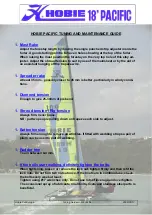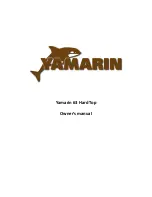
ELECTROLYSIS AND ZINC ANODES
Many boaters are unaware of the problems associ-
ated with electrolysis and how to properly address
corrosion issues. Electrolysis is a reaction between
metal and electrical energy. Electrolysis occurs
when electrical current is “leaking” into the water,
and can come from a variety of sources, such as
ship-to-shore power, sharing electrical wires, old
electrical devices in contact with the water,and bat-
teries in boats, etc.
Electrolysis can also be caused by “stray currents”
resulting from a fault in an electrical item even
though correctly grounded. Your Chaparral boat is
equipped with a galvanic isolator that isolates the
boat from the dockside electrical system.
Electrolysis/corrosion is a very real issue and
expense for any boater, and boat owners must be
aware of the proper protection and maintenance.
Corrosion will directly affect the performance of your
boat within a very short period.
It is the owner’s responsibility to check for and
replace damaged parts resulting form galvanic dete-
rioration. Refer to your Chaparral dealer to investi-
gate the source of stray corrosive currents.
Zinc plates (Figure 7.12) are installed on the tran-
som and trim tabs to protect underwater hardware
on your boat. Zinc is less noble than copper-based
alloys and aluminum used in underwater fittings;
therefore, it will deteriorate first and protect the more
noble parts.
Zinc anodes generally require replacement about
once a year. (In salt water areas, replace every six
months). The need to replace anodes more fre-
quently may indicate a stray current problem within
the boat or at the slip or mooring. If zinc anodes are
not replaced annually, they may not provide the nec-
essary protection.
Note: Do not paint between the zinc and any
metal that it touches. Do not paint over the zinc.
When the AC shore power system is connected to the
boat, the underwater metal fittings are connected
through the water to grounded metals ashore. The
zincs will be consumed as a faster rate unless the
marina maintains a protective system to prevent this.
Placing zinc in the water bonded to the metal outlet
box on the dock will reduce zinc loss on the boat. Do
not connect this zinc to the boat’s ground system.
Important: All electrically operated DC equip-
ment and accessories must be wired so that the
ground polarity of each device is the same as
that of the battery. Chaparral boats have a nega-
tive ground system, which is recommended
practice throughout the marine industry. All
metal items (fuel tanks, underwater hardware) in
the boat are connected to the zinc anode by the
green bonding wire.
Electrolysis can also be caused by “stray currents”
resulting from a fault in an electrical item, even
though correctly grounded. Chaparral has equipped
your boat with a galvanic isolator.
7-14
CAUTION:
Replace zinc sacrificial anodes if
they are corroded by 50% or more.
ZINC ANODES
SWIM
PLATFORM
(UNDERNEATH)
SWIM
PLATFORM
BRACING
PORT SIDE SHOWN (STARBOARD IS TYPICAL)
ZINC ANODES
TRANSOM
Figure 7.12 Zinc Plate Locations
Summary of Contents for 420 PREMIERE
Page 10: ...1 6...
Page 11: ...1 7...
Page 12: ...1 8...
Page 16: ...1 12...
Page 42: ...3 6 Figure 3 5 Hardtop Layout...
Page 44: ...3 8 Figure 3 8 Helm Layout...
Page 68: ...5 6...
Page 87: ...7 15 Figure 7 10 10 Way Fuse Block...
Page 88: ...7 16 Figure 7 11 3 Row Helm Circuit Breaker Panel...
Page 89: ...7 17 Figure 7 12 Bilge Panel...
Page 90: ...7 18 Figure 7 13 Aft Bond Buss 1 Model...
Page 91: ...7 19 18 Figure 7 14 MP3 SW Panel...
Page 92: ...7 20 Figure 7 15 Port Switch Panel 1...
Page 93: ...7 21 Figure 7 16 Port Switch Panel 2...
Page 94: ...7 22 Figure 7 17 Port Switch Panel 3...
Page 95: ...7 23 Figure 7 18 Port Component Panel...
Page 96: ...7 24 Figure 7 19 Starboard Switch Panel 1...
Page 97: ...7 25 Figure 7 20 Starboard Switch Panel 2...
Page 98: ...7 26 Figure 7 21 Starboard Component Panel...
Page 99: ...7 27 Figure 7 22 Bilge Distribution Harness Model 1...
Page 100: ...7 28 Figure 7 23 Bilge Distribution Harness Model 2...
Page 101: ...7 29 Figure 7 24 Bilge Distribution Harness Model 3...
Page 102: ...7 30 Figure 7 25 Bilge Distribution Harness Model 4...
Page 103: ...7 31 Figure 7 26 Bilge Distribution Harness Model 5...
Page 104: ...7 32 Figure 7 27 XAC Cabin Harness Model...
Page 105: ...7 33 Figure 7 28 XSofa Lite Harness Model...
Page 106: ...7 34 Figure 7 29 Galley Overhead Light Harness 1...
Page 107: ...7 35 Figure 7 30 Forward Overhead Light Harness 2...
Page 108: ...7 36 Figure 7 31 Forward Overhead Light Harness 3...
Page 109: ...7 37 Figure 7 32 X009 1300570 Sub Floor Model...
Page 110: ...7 38 Figure 7 33 AC Cabin Harness...
Page 111: ...7 39 Figure 7 34 2010 Volvo IPS Ignition Harness 1...
Page 112: ...7 40 Figure 7 35 2010 Volvo IUPS Ignition Harness 2...
Page 113: ...7 41 Figure 7 36 2010 Volvo IUPS Ignition Harness 3...
Page 114: ...7 42 Figure 7 37 2010 Volvo IPS Ignition Harness 4...
Page 115: ...7 43 Figure 7 38 Hardtop Harness...
Page 116: ...7 44 Figure 7 39 Sunroof Switch Assembly...
Page 117: ...7 45 Figure 7 40 Spotlight Harness...
Page 118: ...7 46 Figure 7 41Grill Outlet Harness...
Page 119: ...7 47 Figure 7 42 Wet Bar Harness Model...
Page 120: ...7 48 Figure 7 43 Wet Bar Outlet Harness...
Page 121: ...7 49 Figure 7 44 Vent Light Harness Model...
Page 122: ...7 50 Figure 7 45 Windlass and Horn 420 DA Model...
Page 124: ...7 52...
Page 138: ...8 14...
Page 156: ...10 6...
Page 164: ...11 8...
















































